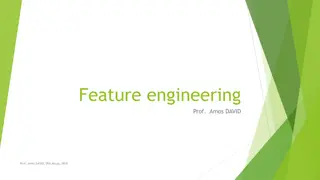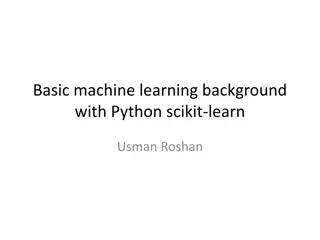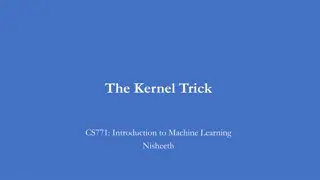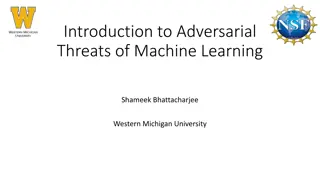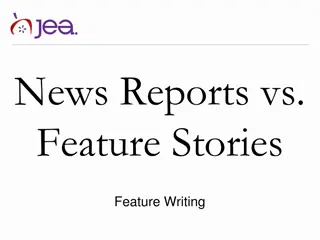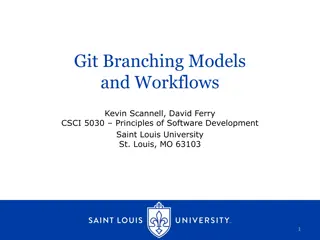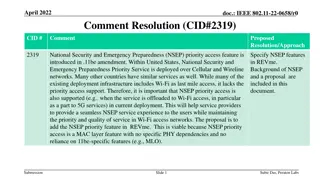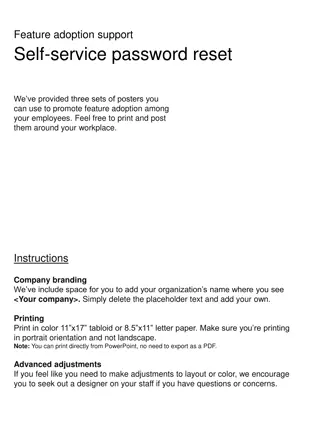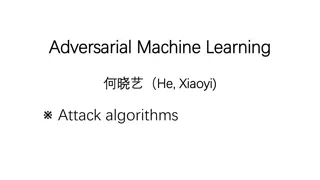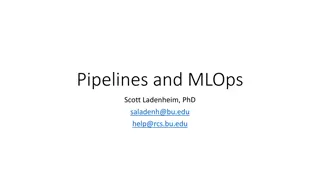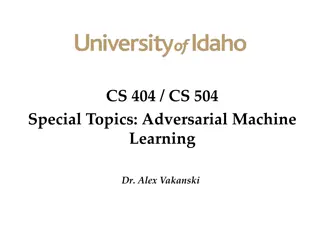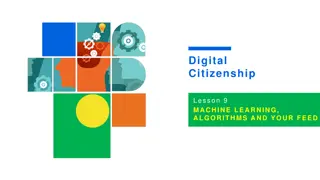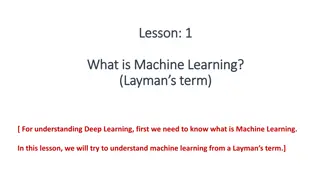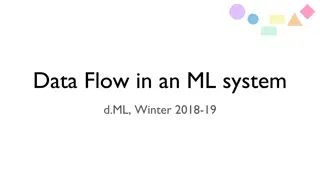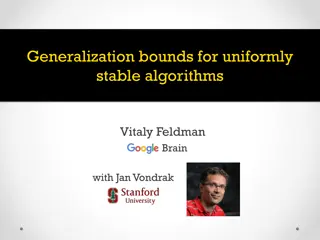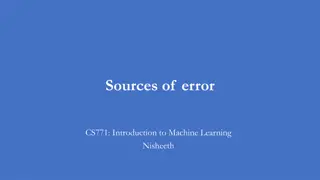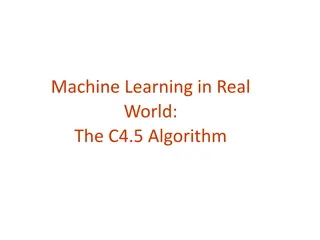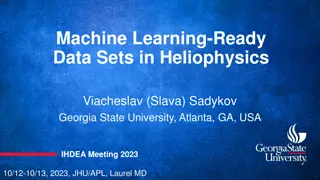Understanding Feature Engineering in Machine Learning
Feature engineering involves transforming raw data into meaningful features to improve the performance of machine learning models. This process includes selecting, iterating, and improving features, converting context to input for learning algorithms, and balancing the complexity of features, concepts, models, and data. Different types of features include categorical, binary, and numeric, with various transformations like converting between feature types and encoding features for better model understanding.
Download Presentation

Please find below an Image/Link to download the presentation.
The content on the website is provided AS IS for your information and personal use only. It may not be sold, licensed, or shared on other websites without obtaining consent from the author. Download presentation by click this link. If you encounter any issues during the download, it is possible that the publisher has removed the file from their server.
E N D
Presentation Transcript
Feature Engineering Geoff Hulten
Overview Feature engineering overview Common approaches to featurizing with text Feature selection Iterating and improving (and dealing with mistakes)
Goals of Feature Engineering Convert context -> input to learning algorithm. Expose the structure of the concept to the learning algorithm. Work well with the structure of the model the algorithm will create. Balance number of features, complexity of concept, complexity of model, amount of data.
Sample from SMS Spam SMS Message (arbitrary text) -> 5 dimensional array of binary features 1 if message is longer than 40 chars, 0 otherwise 1 if message contains a digit, 0 otherwise 1 if message contains word call , 0 otherwise 1 if message contains word to , 0 otherwise 1 if message contains word your , 0 otherwise SIX chances to win CASH! From 100 to 20,000 pounds txt> CSH11 and send to 87575. Cost 150p/day, 6days, 16+ TsandCs apply Reply HL 4 info Long? HasDigit? ContainsWord(Call) ContainsWord(to) ContainsWord(your)
Basic Feature Types Categorical Features Binary Features Numeric Features CountOfWord(call) ContainsWord(call)? FirstWordPOS -> { Verb, Noun, Other } MessageLength IsLongSMSMessage? MessageLength -> { Short, Medium, Long, VeryLong } FirstNumberInMessage Contains(*#)? TokenType -> { Number, URL, Word, Phone#, Unknown } WritingGradeLevel ContainsPunctuation? GrammarAnalysis -> { Fragment, SimpleSentence, ComplexSentence }
Converting Between Feature Types Numeric Feature => Binary Feature Length of text + [ 40 ] => { 0, 1 } Single threshold Numeric Feature => Categorical Feature Length of text + [ 20, 40 ] => { short or medium or long } Set of thresholds Categorical Feature => Binary Features { short or medium or long } => [ 1, 0, 0] or [ 0, 1, 0] or [0, 0, 1] One-hot encoding Binary Feature => Numeric Feature { 0, 1 } => { 0, 1 }
Sources of Data for Features System State App in foreground? Roaming? Sensor readings Interaction History User s report as junk rate # previous interactions with sender # messages sent/received Content Analysis Stuff we ve been talking about Stuff we re going to talk about next Metadata Properties of phone #s referenced Properties of the sender Run other models on the content Grammar Language User Information Industry Demographics
Feature Engineering for Text Tokenizing TF-IDF Bag of Words Embeddings N-grams NLP
Tokenizing Breaking text into words Nah, I don't think he goes to usf -> [ Nah, I , don't , think , he , goes , to , usf ] Some tips for deciding If you have lots of data / optimization Keep as much information as possible Let the learning algorithm figure out what is important and what isn t Dealing with punctuation Nah, -> [ Nah, ] or [ Nah , , ] or [ Nah ] don't -> [ don't ] or [ don , ' , t ] or [ don , t ] or [ do , n't ] If you don t have much data / optimization... Reduce the number of features you maintain Normalize away irrelevant things Normalizing Nah, -> Focus on things relevant to the concept Explore data / use your intuition Overfitting / underfitting much more later [ Nah, ] or [ nah, ] 1452 -> [ 1452 ] or [ <number> ]
Bag of Words One feature per unique token Bag of words ?1 ?2 ?3 ?4 ?5 ?6 ?7 ?8 ?9 ?10 a of word text word a of is word m1: m2: m3: m4: A word of text. A word is a token. Tokens and features. Few features of text. text a a is token token features tokens tokens and features and few of features text few Training data Tokens Features
Bag of Words: Example test1: Some features for a text example. m1 m1 m2 m2 m3 m3 m4 m4 test1 test1 Out of vocabulary ?1 ?2 ?3 ?4 ?5 ?6 ?7 ?8 ?9 ?10 ?1 ?2 ?3 ?4 ?5 ?6 ?7 ?8 ?9 ?10 ?10 0 ?1 ?2 ?3 ?4 ?5 ?6 ?7 ?8 ?9 ?10 ?10 ?1 ?2 ?3 ?4 ?5 ?6 ?7 ?8 ?9 ?1 ?2 ?3 ?4 ?5 ?6 ?7 ?8 ?9 a 1 1 0 0 1 word 1 1 0 0 0 of 1 0 0 1 0 text 1 0 0 1 1 m1: m2: m3: m4: A word of text. A word is a token. Tokens and features. Few features of text. is 0 1 0 0 0 token 0 1 0 0 0 tokens 0 0 1 0 0 and 0 0 1 0 0 features 0 0 1 1 1 few 0 0 1 0 Test X Selected Features Training X Use bag of words when you have a lot of data, can use many features
N-Grams: Tokens Instead of using single tokens as features, use series of N tokens down the bank vs from the bank Message 1: Nah I don't think he goes to usf Message 2: Text FA to 87121 to receive entry Nah I I don t don t think think he he goes goes to to usf Text FA FA to 87121 to To receive receive entry Message 2: 0 0 0 0 0 0 0 1 1 1 1 1 Use when you have a LOT of data, can use MANY features
N-Grams: Characters Instead of using series of tokens, use series of characters Message 1: Nah I don't think he goes to usf Message 2: Text FA to 87121 to receive entry Na ah h <space> <space> I I <space> <space> d do <space> e en nt tr ry Message 2: 0 0 0 0 0 0 0 1 1 1 1 1 Helps with out of dictionary words & spelling errors Fixed number of features for given N (but can be very large)
TF-IDF Term Frequency Inverse Document Frequency Term IDF Score 4 3.5 Instead of using binary: ContainsWord(<term>) Use numeric importance score TF-IDF: 3 2.5 2 Importance to Document TermFrequency(<term>, <document>) = % of the words in <document> that are <term> 1.5 1 0.5 InverseDocumentFrequency(<term>, <documents>) = log ( # documents / # documents that contain <term> ) 0 Novelty across corpus 0% 20% 40% 60% 80% 100% % of Documents Containing Term Words that occur in many documents have low score (??) Message 1: Nah I don't think he goes to usf Message 2: Text FA to 87121 to receive entry Nah I don't think he goes to usf Text FA 87121 receive entry BOW 0 0 0 0 0 0 1 0 1 1 1 1 1 Message 2: TF-IDF 0 0 0 0 0 0 0 0 .099 .099 .099 .099 .099
Embeddings -- Word2Vec and FastText Word -> Coordinate in N dimension Regions of space contain similar concepts Creating Features Options: Average vector across words Count in specific regions Commonly used with neural networks Replaces words with their meanings sparse -> dense representation
Normalization (Numeric => Better Numeric) Helps make model s job easier No need to learn what is big or small for the feature Normalize Mean Normalize Variance Raw X 36 74 22 81 105 113 77 91 -38.875 -0.875 -52.875 6.125 30.125 38.125 2.125 16.125 -1.31696 -0.02964 -1.79123 0.207495 1.020536 1.29155 0.071988 0.546262 Some model types benefit more than others Subtract Mean Divide by Stdev To use in practice: Estimate mean/stdev on training data Mean: 74.875 Mean: 0 Std: 29.5188 Mean: 0 Std: 1 Apply normalization using those parameters to validation /train
Feature Selection Which features to use? How many features to use? Approaches: Frequency Mutual Information Accuracy
Feature Selection: Frequency Take top N most common features in the training set Feature Count to 1745 you 1526 I 1369 a 1337 the 1007 and 758 in 400
Feature Selection: Mutual Information Take N that contain most information about target on the training set ?(?,?) ? ? ?(?)) ?? ?,? = ? ?,? ???( ? ? ? ? ? ? 1 0 ? ? = ?,? = ? ? ? = ? ? ? = ? .? 0 0 ? ? = ?,? = ? ??? = .? ??? = ?.??? .? .? 0 0 0 0 ? = 0 ? = 1 Sum over all combinations: MI = 0.086 1 1 ? = 0 3 1 ? = 1 Contingency Table 2 4 1 1 0 1 ? = 0 ? = 1 0 1 Perfect predictor high MI ? = 0 10 0 1 1 ? = 1 0 10 1 1 x=0 x=1 Training Data No Information 0 MI ? = 0 5 5 ? = 1 5 5 ??? +? ?+? Additive Smoothing to avoid 0s: ? =
Feature Selection: Accuracy (wrapper) Take N that improve accuracy most on hold out data Greedy search, adding or removing features From baseline, try adding (removing) each candidate Build a model Evaluate on hold out data Add (remove) the best Repeat till you get to N Remove Accuracy <None> 88.2% claim 82.1% FREE 86.5% or 87.8% to 89.8%
Important note about feature selection Do not use validation (or test) data when doing feature selection Use train data only to select features Then apply the selected features to the validation (or test) data
Simple Feature Engineering Pattern Input for machine learning model at runtime TrainingContextX runtimeContextX Featurize Runtime Featurize Training runtimeX TrainingY Featurize Data Selected words / n-grams and their feature indexes TF-IDF weights to use for each word Raw data to featurize and do feature selection with Info needed to turn raw context into features Normalize parameters for numeric features: means and stdevs
Simple Feature Engineering Pattern: Pseudocode for f in featureSelectionMethodsToTry: (trainX, trainY, featureData) = FeaturizeTraining(rawTrainX, rawTrainY, f) (validationX, validationY) = FeaturizeRuntime(rawValidationX, rawValidationY, f, featureData) for hp in hyperParametersToTry: model.fit(trainX, trainY, hp) accuracies[hp, f] = evaluate(validationY, model.predict(validationX)) (bestHyperParametersFound, bestFeaturizerFound) = bestSettingFound(accuracies) (finalTrainX, finalTrainY, featureData) = FeaturizeTraining(rawTrainX + rawValidationX, rawTrainY + rawValidationY, bestFeaturizerFound) (testX, testY) = FeaturizeRuntime(rawTextX, rawTestY, bestFeaturizerFound, featureData) finalModel.fit(finalTrainX, finalTrainY, bestHyperParametersFound) estimateOfGeneralizationPerformance = evaluate(testY, model.predict(testX))
Understanding Mistakes Noise in the data Encodings Bugs Missing values Corruption Noise in the labels Ham: As per your request 'Melle Melle (Oru Minnaminunginte Nurungu Vettam)' has been set as your callertune for all Callers. Press *9 to copy your friends Callertune Spam:I ll meet you at the resturant between 10 & 10:30 can t wait! Model being wrong Reason?
Exploring Mistakes Examine N random false positive and N random false negatives Reason Count Label Noise 2 Slang 5 Non-English 5 Examine N worst false positives and N worst false negatives Model predicts very near 1, but true answer is 0 Model predicts very near 0, but true answer is 1
Approach to Feature Engineering Start with standard for your domain; 1 parameter per ~10 samples Try all the important variations on hold out data Tokenizing Bag of words N-grams Use some form of feature selection to find the best, evaluate Look at your mistakes Use your intuition about your domain and adapt standard approaches or invent new features Iterate When you want to know how well you did, evaluate on test data
Feature Engineering in Other Domains Computer Vision: Gradients Histograms Convolutions Internet: IP Parts Domains Relationships Reputation Time Series: Window aggregated statistics Frequency domain transformations Neural Networks: A whole bunch of other things we ll talk about later
Summary of Feature Engineering Feature engineering converts raw context into inputs for machine learning Every domain has a library of proven feature engineering approaches Text s include: normalization, tokenizing, n-grams, TF-IDF, embeddings, & NLP Goals are: Match structure of concept to structure of model representation Balance number of feature, amount of data, complexity of concept, power of model Feature selection removes less useful features and can greatly increase accuracy








